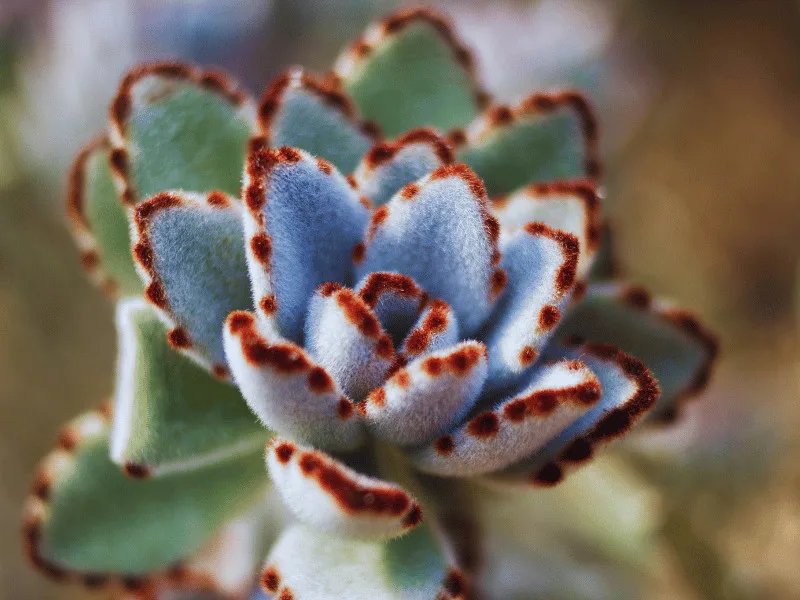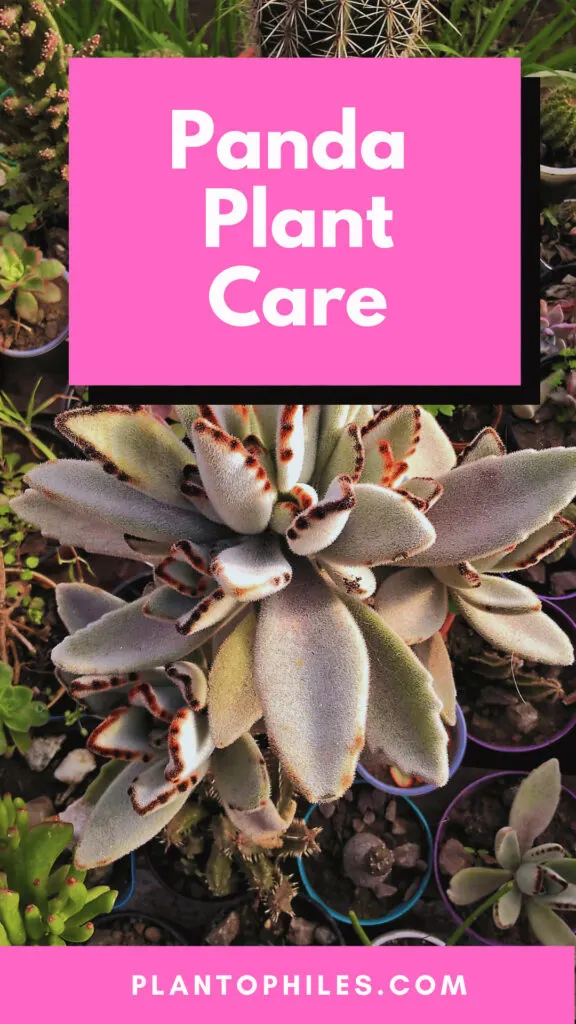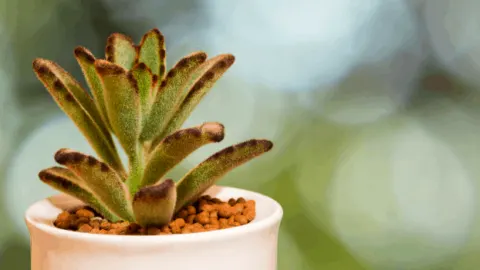The Panda plant is a succulent often grown as a houseplant. Here is what you need to know about this species and how to care for it.

Most Crucial Beginner Tips to Have a Thriving Chocolate Soldier Plant
Little and mighty, the Panda plant makes for a great addition to any household. They’re conveniently small, velvety, and easy keepers. Here are the most important aspects when caring for these succulents!
1. Provide your plant with a potting mix designed for succulents!
2. Panda plants require an area that has a mixture of both shade and sunshine.
3. Your home should stay between 59-73°F (15-23°C).
4. Don’t overdo it on watering, only adding more moisture once the plant has dried out completely.
5. Watch for pests like mealybugs, scale insects, and red spider mites!
Want to keep with the desert theme? Read my article containing the best indoor cacti!
Takeaways
| Species | Kalanchoe tomentosa |
|---|---|
| Synonyms | Panda Plant, Pussy Ears, Chocolate Soldier |
| Family | Crassulaceae |
| Genus | Kalanchoe |
| Growth | Compact, Spreading |
| Height | 1ft / 0.3m |
| Width | 1ft / 0.3m |
| Soil | Well-draining soil mix |
| Watering | Every 7 – 14 days |
| Light | Bright indirect |
| Temperature | 65 – 80°F / 18.3 – 26.7°C |
| Humidity | 40 – 60% |
| Fertilizer | Once a month |
| Propagation | Stem cuttings, leaf cuttings |
| Toxicity | Highly Toxic. Keep away from cats and dogs and children |
The Panda Plant
The Panda plant (Kalanchoe tomentosa) is native only to the island of Madagascar, making them a rare endemic species. Housing these floras indoors is much easier than you think, as long as you meet their basic needs.
The common name Panda plant refers to the soft, fuzzy lining of hairs along the foliage, according to the University of Florida. They are part of the Crassulaceae family (Stonecrops)
Panda plants are succulents. Those hairy, fleshy leaves held to store water amid a drought.
Table of Contents
Panda Plant Care – The Essentials for Beginners
Kalanchoe tomentosa is a great houseplant to add to your collection for several reasons. They don’t take up too much space, add a touch of desert flair, and aren’t picky regarding their needs.
Soil – Succulents Like it Dry
Use a cactus and succulent soil mix. Desert plants need different types of nutrients compared to other houseplants.
To mix your own cactus mix use perlite, loam, and clay. Use a pot with drainage holes. Excess water can drain this way. Your plant won’t sit in water.
The roots of a succulent are not able to handle lots of humidity. Growing in desert-like conditions, they lack water tolerance.
Light – Is important, but don’t overdo it.
Bright indirect light is ideal. Avoid direct sunlight for more than 3-4 hours per day.
Those velvety leaves you find on a Panda plant need quite a bit of sunshine. Succulents, in general, are avid light lovers.
Watering – Only a bit
Water once a week once the soil is dry.
Temperature
The ideal temperature is 59-73°F (15-23°C).
The Panda plant can tolerate temperatures slightly higher or lower than this range. Living in the desert, these individuals face a wide range of temperatures. The only thing that they can’t handle is when it dips below freezing.
Humidity
A humidity between 40-50% is sufficient. Cacti usually don’t love it humid. The average house generally has about 40 percent relative humidity.
Fertilizer – Use it in Spring and Summer
Fertilizer once a month in spring and summer. Do not feed in autumn and winter as these succulents are dormant from autumn to winter.
Panda Plant Propagation
Panda plants can be propagated through leaf cuttings.
You can also do this through seed germination, though this may take a lot longer.
All you need to do is cut the leaves into sections and plant them in a pot with fresh soil.
As with most plants, Panda plant propagation should be during the spring and summer months. Use sharp, disinfected scissors.
Panda Plant Leaf Cutting Propagation Steps
With sharp scissors, find a few leaves that have grown to be quite healthy and full. Don’t take more than three or four, as this can damage your plant.
Place these leaf cuttings into a pot with freshly laid soil, the best results usually being with a perlite mixture.
Don’t add any water just yet. Wait a week so that the Panda plant cuttings can dry out. Don’t wait any longer than that, or else they won’t root.
Your cuttings will do better when placed in a spot with plenty of indirect sunlight. Once the soil has been completely dried out, you can mist the leaves. You won’t want to do this to an adult, but fresh growth is a separate story!
Watch closely for roots to form. This will likely be within three to five weeks. The development of new leaves will also accompany this.
Once roots have formed, you can transfer your new Panda plant to a larger container, and continue caring for it as if it were an adult.
Growth
Kalanchoe tomentosa grows up to 3ft tall (90 cm). They are slow growers.
Potting
Repot once every two or three years.

Panda Plant Pests
The most common pests are mealybugs, scale insects, and red spider mites.
Mealybugs are found where the leaves and the stems join together.
You can treat these little buggers by spraying down the plant with rubbing alcohol. Only apply this to the affected areas. Scale insects look like little black dots and are generally treated through insecticides.
Spider mites require that you either hose down the leaves and stems or use bug-killing sprays.
Does my Kalanchoe tomentosa have Root Rot?
The most severe disease that you have to watch out for with a Panda plant is root rot. Fortunately, this can be easily avoided. Remember how these succulents don’t take well to being overwatered?
Well, this is your answer. If you are mindful of how often you water your Panda plant, you shouldn’t have a problem. Root rot results from the plant having to sit in water for too long.
If you catch it early enough, you can treat root rot by removing any mushy parts and roots. Run the bottom portion of your plant under water and disinfect the container and soil. Use new potting soil and replant.
The Leaves are Drying Up
Succulent leaves can go through phases of dying back and being revived. But, if you see a continuous problem with dried leaves, particularly at the bottom, you’ll want to figure out a solution. This is generally because of not enough water.
Remove any dead or dying leaves first. You will then want to implement a more frequent watering schedule.
Leaves are Yellowing and Becoming Mushy
This combination is a way of telling you that you have given it too much water.
Overwatering is an easy fix. Simply allow the water to dry out between watering sessions. Take note of the soil and how damp it is before adding moisture.
Why does a Panda Plant have Black Spots on the Foliage?
The presence of black spots can either be one of two things. You either have scale insects, or the plant has been highly overwatered.
We suggest figuring out if it is a water problem before moving on to the potential bug infestation. If holding back on moisture doesn’t work, invest in some insecticides.
A White Web-Like Substance is on the Leaves
This white substance forming on the leaves of a Panda plant is a sign of spider mites.
Spider mites are pesky insects. Rubbing alcohol tends to work well. You can apply it through a cotton ball to the affected areas. Another method is to use pesticides. Just be sure to do your research first!
FAQ
Is the Panda plant poisonous?
The Panda plant is poisonous. If you ingest this flora, you may experience vomiting, diarrhea, and decreased energy.
Are there different varieties of the Panda plant?
The Panda plant comes in several colors, usually blue to green.
What makes the Panda plant a succulent?
One of the biggest ways you can tell it is succulent is by those fleshy leaves. A lot of desert dwellers have them to store water!
The last Panda
Panda plants are easy to care for if you do not overwater them. Always use your index finger and only water once the soil is completely dry.

Daniel has been a plant enthusiast for over 20 years. He owns hundreds of houseplants and prepares for the chili growing seasons yearly with great anticipation. His favorite plants are plant species in the Araceae family, such as Monstera, Philodendron, and Anthurium. He also loves gardening and is growing hot peppers, tomatoes, and many more vegetables.


